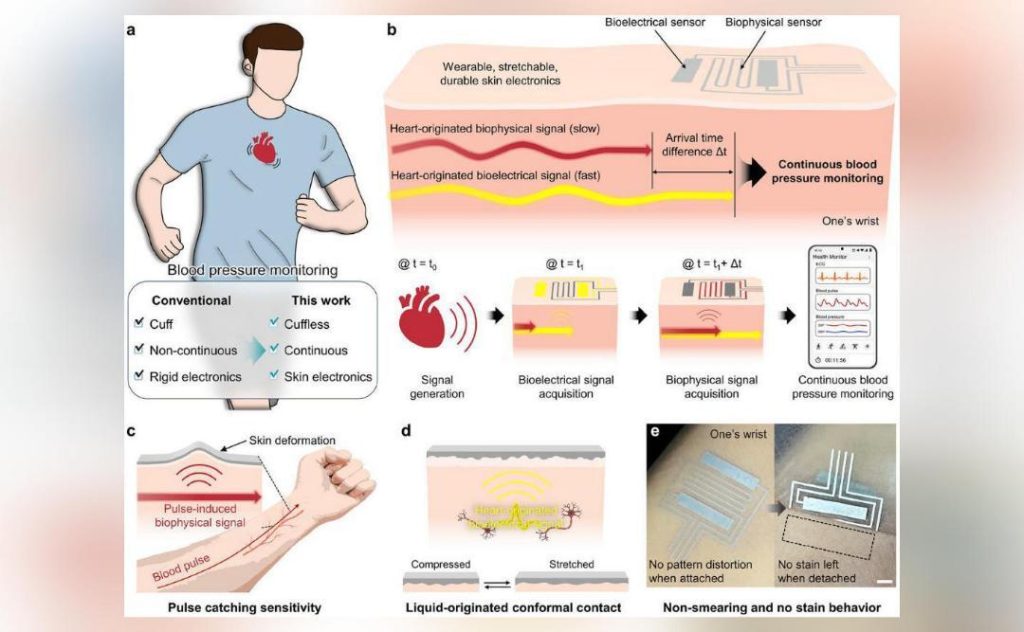
Band-Aid-like Wearable Blood Pressure Monitor Developed for Real-Time Measurement
Monitoring blood pressure is a crucial aspect of maintaining good health, and with the increasing prevalence of hypertension, it has become more important than ever. However, traditional methods of measuring blood pressure, such as manual cuff-based measurements, can be inconvenient, inaccurate, and sometimes painful. Researchers at the Seoul National University College of Engineering have developed a wearable electronic device that attaches to the skin like a band-aid and enables real-time, continuous monitoring of blood pressure over extended periods. This innovative device has the potential to revolutionize the way we monitor blood pressure, making it more convenient, accurate, and accessible.
The wearable blood pressure monitor, developed by a team of researchers led by Professor Sung-Joon Cho, is a flexible, stretchable electronic device that can be attached to the skin like a band-aid. The device is designed to be comfortable, flexible, and adaptable to the natural movement of the body. According to the researchers, the device maintains its performance even when stretched to 700% of its original length or repeatedly stretched more than 10,000 times.
The device uses a novel combination of sensors and stretchable electronics to measure blood pressure. The sensors are integrated into a thin, flexible film that is attached to the skin, and the stretchable electronics allow the device to move with the body without compromising its performance. The device is designed to be worn on the wrist, similar to a smartwatch, but it can also be attached to other parts of the body, such as the upper arm or thigh.
The researchers used a variety of techniques to develop the device, including 3D printing, vacuum molding, and laser cutting. They also used advanced materials, such as elastomers and silicone rubber, to create the flexible and stretchable electronics. The device is powered by a small battery, and the data is transmitted wirelessly to a smartphone or computer.
The wearable blood pressure monitor has several advantages over traditional methods of measuring blood pressure. For one, it provides real-time data, allowing individuals to track their blood pressure levels continuously throughout the day. This can be especially useful for people with hypertension, who need to monitor their blood pressure regularly to manage their condition. The device is also more convenient than traditional methods, as it does not require a separate device or someone else to take the measurement.
Another advantage of the wearable blood pressure monitor is its ability to measure blood pressure in real-time, even in people with irregular heartbeat or other cardiovascular conditions. Traditional methods of measuring blood pressure can be inaccurate in these individuals, as they require a steady heartbeat and a calm environment. The wearable device, on the other hand, can accurately measure blood pressure even in people with irregular heartbeat or other cardiovascular conditions.
The researchers have tested the wearable blood pressure monitor in a series of experiments, and the results are promising. The device was able to accurately measure blood pressure in people with hypertension, and it was able to detect changes in blood pressure in response to exercise and other activities. The device was also able to transmit data wirelessly to a smartphone or computer, allowing individuals to track their blood pressure levels remotely.
The wearable blood pressure monitor has the potential to revolutionize the way we monitor blood pressure, making it more convenient, accurate, and accessible. It could also be used to monitor blood pressure in people with chronic conditions, such as heart failure or kidney disease, allowing them to track their blood pressure levels continuously and adjust their treatment plans accordingly.
In conclusion, the wearable blood pressure monitor developed by the researchers at the Seoul National University College of Engineering is a groundbreaking device that has the potential to revolutionize the way we monitor blood pressure. Its ability to attach to the skin like a band-aid, provide real-time data, and accurately measure blood pressure in people with irregular heartbeat or other cardiovascular conditions makes it an innovative and practical solution for monitoring blood pressure.






